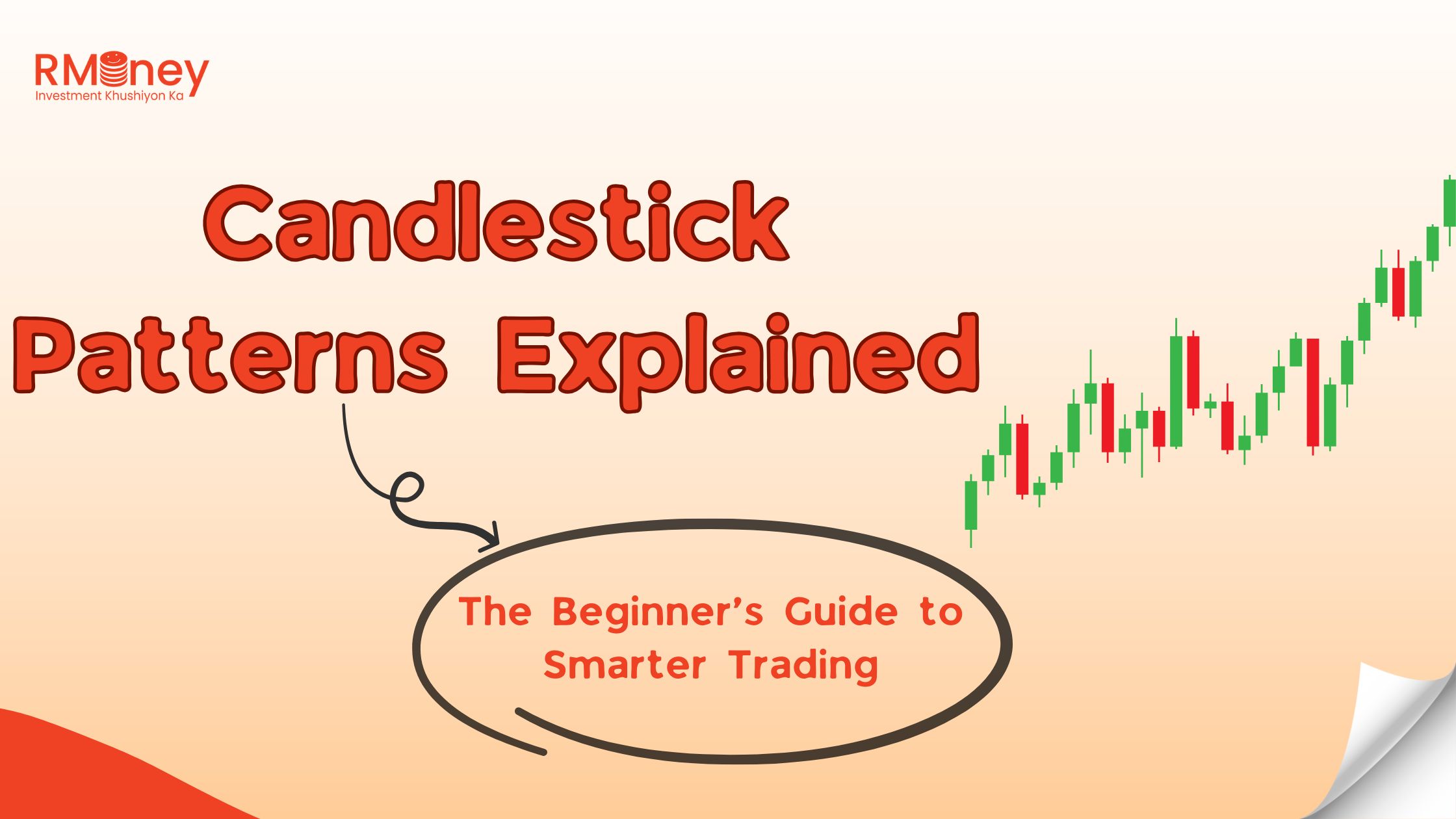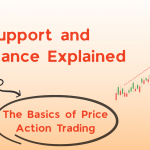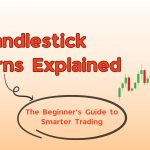When you look at a stock chart you probably notice candlesticks. These are the small green and red bars that show how the market price goes up and down. At first candlestick charts can seem confusing but they are one of the best tools for traders. They help you understand price movements and make smarter trading choices.
This guide will help beginners understand candlestick patterns step by step. By the end, you’ll know how to read candlesticks, identify common patterns, and use them to make smarter trading decisions while avoiding costly mistakes.
What Are Candlestick Charts?
Candlestick charts were created in Japan in the 18th century. When rice traders used them for tracking price movement. Today, they have become a world standard for technical analysis in stocks, forex, commodities and crypto.
Each candlestick displays price action in a specific time frame. These time frames can be one minute, one hour, one day, or one week. A candlestick displays four key pieces of data:
- Open: The cost at the start of the time period
- Close: The price at the end of the time period
- High: The most price reached during the time period
- Low: The least price reached during the time period
The candlestick shows two basic items:
- Body: The box between the open and close price. A green (or white) body says the close price is greater than the open price (bullish), and a red (or black) body says the close price is less than the open price (bearish).
- Wicks (or Shadows): The thin, long lines above and below the body that extend to the overall high and low of the session.
Combined, the candlestick shows several visual patterns that illustrate trader psychology and who is winning the battle between buyers and sellers.
Why Candlestick Patterns Matter ?
Human emotions, such as fear, greed, hope, and second-guessing, influence price changes. As traders, candlestick patterns graphically depict our emotions. The market may move if a number of traders notice the same candlestick pattern, which could create a self-fulfilling prophecy.
For any beginner, studying candlestick patterns can last for a long time:
- Assist in determining entry and exits points
- Confirm other technical set-ups
- Help improve risk management by catching reversals early
- Assist in having more confidence to make decisions instead of guessing.

Types of Candlestick Patterns
Candlestick patterns are generally grouped into two general categories: reversal patterns (indicate a change in trend) and continuation patterns (indicates that the trend is likely to continue).
Let’s go over a few of the more important ones.
1. Doji – The Market in Indecision

A Doji is formed when the opening and closing prices are nearly the same price point. A Doji on a candlestick chart looks similar to a cross or plus sign.
What it signifies:
This signifies indecision in the market. There is balance between buyers and sellers; they are evenly matched. Depending on where it is formed, this can mean either a market reversal or simply a pause.
For example:
If a Doji is formed after a strong uptrend, it could mean buying pressure is specifically weakening.
2. Hammer – A Bullish Reversal

The Hammer candlestick pattern has a longer lower wick and a smaller body near the top.
What it means:
At one point during the session, sellers lowered the price down, but buyers stepped in and raised it again. This suggests that there is a lot of interest in purchasing at reduced costs.
Where it results:
It typically signals a potential reversal at the bottom of a downward trend.
3. Shooting Star – A Bearish Reversal

The Hammer’s opposite is the Shooting Star. It features a little body toward the bottom and a lengthy upper wick.
What it means:
Sellers took control and the buyers could not lift prices.
Where it appears:
It appears near the peak of an upward trend and could be a reversal indicator.
4. Bullish Engulfing – Buyers Take Charge

When a large green candlestick completely covers a small red candlestick, you have this pattern.
What it means:
The momentum is now bullish.
Where it appears:
It signifies the bullish reversal at the end of a bearish trend.
5. Bearish Engulfing – Sellers Dominate

The reverse of bullish engulfing is bearish engulfing. A big red candle came after a tiny green one.
What it means:
Sellers have gained control over buyers.
Where it appears:
A bearish reversal is observed at the end of an upward trend.
6. Morning Star – A Strong Bullish Signal

A Morning Star is a pattern that consists of three candles:
- A long red candle followed by
- A small bodied candle (it can either be red or green) followed by
- A long green candle.
What it means:
It implies that the urge to sell has decreased and that buyers have started to show up.
Where does it appear?
When the downtrend reaches its lowest point a strong reversal can happen.
7. Evening Star – A Strong Bearish Signal

The inverse of the Morning Star:
- A long green bar
- A small-bodied bar
- A long red bar
What it Signals:
The uptrend is slowing down and sellers are in charge.
Where it appears:
It predicts a change at the top of a rising trend.
8. Three Black Crows – Consistent Selling Pressure

This behavior shows as three long red candles each closing lower than the candle preceding it.
What it means:
To identify this formation all on board one must acknowledge that there is strong and sustained selling pressure.
Where it develops: A change in the trend is usually observed at the highest point of an upward trend.
9. Three White Soldiers – Consistent Buying Pressure

In basic terms, Three Green Soldiers is the opposite of Three Black Crows (see above). It is made up of three long green candles, each of which closes higher than the one before it.
What it signifies:
Bullish sentiment is confirmed by strong buying momentum.
Where it happens:
Usually following a downward trend that indicates a price action reversal or bottoming.
10. Dark Cloud Cover – A Bearish Warning

A red candle comes after a green candle. The red candle starts at a higher price but ends below the middle point of the earlier green candle.
What it means:
Sellers have begun to outweigh the buyers after an uptrend.
Where it appears:
At the peak of a rising trend this setup is likely to signal a downward turn.
Tips for Using Candlestick Patterns Effectively
When utilized alone, candlestick patterns can still be harmless and useful. The following are some wise trading pointers:
- Volume: A pattern with more volume is more powerful than one without any.
- Trend: In a downturn, a bullish reversal pattern will work better, and vice versa.
- Support and resistance: A more significant pattern is one that is near a level of support and resistance.
- Indicators: By utilizing indicators like Bollinger Bands, RSI, and Moving Averages, you may go beyond candlestick patterns.
- Charts for Trade Demonstration: Before you begin trading with real money, always backtest your candlestick patterns on your demo charts.
Common Mistakes Beginners Make
- Imposing Patterns: Sometimes a price movement doesn’t match exactly with a known pattern, so don’t try to make it fit in a pattern, it isn’t always there.
- Ignoring Context: A Hammer that is in the middle of an uptrend does not mean anything. You need the context.
- Not using a stop-loss: Even a strong pattern can fail! Always manage the risk!
- Too much reliance: Candlestick patterns can complement, but should not replace, your overall trading and management strategy.
Ready to Take the Next Step?
The next step after understanding the basics of candlestick patterns is to apply them. To implement candlestick patterns:
- Before making a real money investment, practice on demo accounts.
- Create a trading journal to document trends and results.
- Integrate risk management techniques with candlestick analysis.
At RMoney, we provide tools, resources, and professional guidance to help both new and experienced traders advance their understanding of the market. Check out our trading platforms and research insights as well if you’re prepared to put what you’ve learned into practice.
After all, every significant move begins with a single candle, so go ahead and start along the path to more intelligent trading.
Disclaimer: This blog is for informational purposes only and should not be taken as financial advice. Readers should consult a qualified advisor before making investment decisions.
About Author

Megha Singh
I have expertise in simplifying complex concepts around trading and investing into clear, practical insights. At RMoney, I write on trading, equity markets, derivatives, and long-term investing to help readers make informed financial decisions. My writing is focused on delivering clarity and confidence to investors at every stage of their journey.

Stock Trading Now trade in ₹9 Per Order or ₹ 999 Per Month Plans.
Future & Options Access F&O contracts with advanced tools for hedging and speculation.
Currency Trading Trade in major currency pairs and manage forex exposure efficiently.
Commodity Trading Diversify Trading with MCX & NCDEX by Trading in Gold, Silver, Base Metals, Energy, and Agri Products.
Margin Trading Funding Boost your buying power with upto 5X, Buy now Pay Later
Algo Trading Back test, Paper Trade your logic & Automate your strategies with low-latency APIs.
Trading View Leverage Trading View charts and indicators integrated into your trading platform.
Advanced Options Trading Execute multi-leg option strategies with precision and insights.
Stock Lending & Borrowing Earn passive income by lending stocks securely through SLB.
Foreign Portfolio Investment Enable NRIs and FPIs to invest in Indian markets with ease and compliance.
IPO Invest in upcoming IPOs online with real-time tracking and instant allotment updates.
Direct Mutual Funds 0% Commissions by investing in more than +3500 Direct Mutual Fund Scheme.
Corporate FDRs Earn fixed returns with low-risk investments in high-rated corporate fixed deposits.
Stocks SIPs Build long-term wealth with systematic investment plans in top-performing stocks.
Bonds & NCDs Access secure, fixed-income investments through government and corporate bond offerings.
Depository Services Safely hold and manage your securities with seamless Demat and DP services with CDSL.
Journey Tracing our growth and milestones over time.
Mission & Vision Guided by purpose, driven by long-term vision.
Why RMoney Platform Smart, reliable platform for all investors' needs.
Management Experienced leadership driving strategic financial excellence.
Credentials Certified expertise with trusted industry recognition.
Press Release Latest company news, updates, and announcements.
Testimonials Real client stories sharing their success journeys.
7 Reasons to Invest Top benefits that make investing with us smart.
SEBI Registered Research Trusted insights backed by SEBI-compliant research.
Our Technology Advanced tools enabling efficient online trading.
Calculators Access a suite of smart tools to plan trades, margins, and returns effectively.
Margin Calculator Instantly check margin requirements for intraday and delivery trades.
MTF Calculator Calculate MTF funding cost upfront to ensure full transparency before placing a trade.
Brokerage Calculator Know your exact brokerage charges before placing any trade.
Market Place Explore curated investment products and trading tools in one convenient hub.
RMoney Gyan Enhance your market knowledge with expert blogs, videos, and tutorials.
Performance Tracker Track our research performance with full transparency using our performance tracker.
Feedback Share your suggestions or concerns to help us improve your experience.
Downloads Access important forms, software, and documents in one place.
Locate Us Find the nearest RMoney branch or service center quickly.
Escalation Matrix Resolve issues faster with our structured support escalation process.
Back Office Log in to view trade reports, ledger, and portfolio statements anytime.
Account Modification Update personal or bank details linked to your trading account.
Fund Transfer Transfer funds instantly online with quick limit updation to your trading account.
Bank Details View our registered bank account details for seamless transactions by NEFT, RTGS or IMPS.
How to Apply IPO Step-by-step guide to apply for IPOs using your trading account.
RMoney Quick Mobile App Trade on-the-go with our all-in-one mobile trading app.
RMoney Quick login Quickly access your trading account through the RMoney Quick web-based trading.
RMoney Rocket Web Version Experience powerful web-based trading with advanced tools for algo traders.
RMoney Rocket Mobile Version Trade anytime, anywhere with our feature-rich mobile trading platform.




















